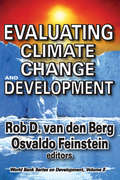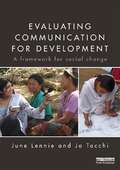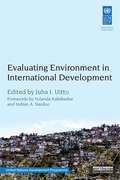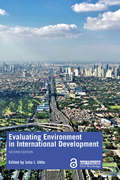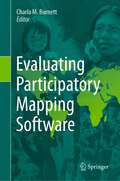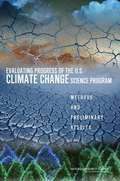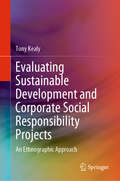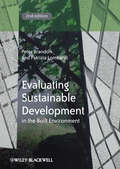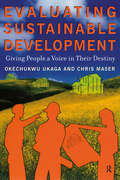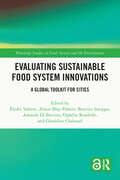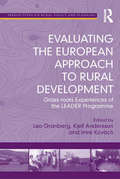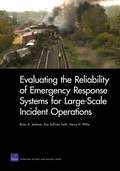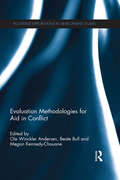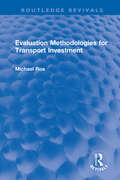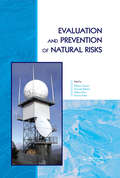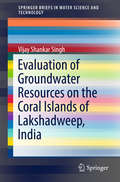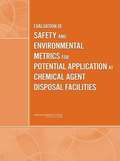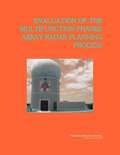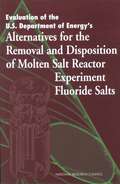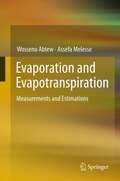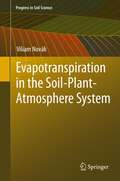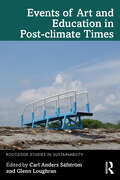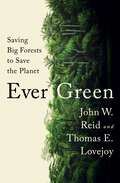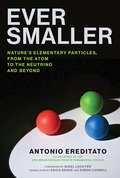- Table View
- List View
Evaluating Climate Change and Development: Volume 9, World Bank Series on Development (World Bank Series On Evaluation And Development Ser. #Vol. 8)
by Osvaldo N. FeinsteinClimate change has become one of the most important global issues of our time, with far-reaching natural, socio-economic, and political effects. To address climate change and development issues from the perspective of evaluation, an international conference was held in Alexandria, Egypt. This book distills the essence of that timely conference, building on the experiences of more than 400 reports and studies presented.Developing countries may be particularly vulnerable to the expected onslaught of higher temperatures, rising sea levels, changing waterfall patterns, and increasing natural disasters. All societies will have to reduce their vulnerability to these changes, and this book describes how vulnerabilities may be addressed in a systematic manner so that governments and local communities may better understand what is happening. Different approaches are also discussed, including the use of human security as a criterion for evaluation as well as ways to deal with risk and uncertainty. Evaluating Climate Change and Development presents a rich variety of methods to assess adaptation through monitoring and evaluation.The volume deals with climate change, development, and evaluation; challenges and lessons learned from evaluations; mitigation of climate change; adaptation to climate change; vulnerability, risks and climate change; and presents a concluding chapter on the road ahead. Collectively the authors offer a set of approaches and techniques for the monitoring and evaluation of climate change.
Evaluating Communication for Development: A Framework for Social Change
by June Lennie Jo TacchiEvaluating Communication for Development presents a comprehensive framework for evaluating communication for development (C4D). This framework combines the latest thinking from a number of fields in new ways. It critiques dominant instrumental, accountability-based approaches to development and evaluation and offers an alternative holistic, participatory, mixed methods approach based on systems and complexity thinking and other key concepts. It maintains a focus on power, gender and other differences and social norms. The authors have designed the framework as a way to focus on achieving sustainable social change and to continually improve and develop C4D initiatives. The benefits and rigour of this approach are supported by examples and case studies from a number of action research and evaluation capacity development projects undertaken by the authors over the past fifteen years. Building on current arguments within the fields of C4D and development, the authors reinforce the case for effective communication being a central and vital component of participatory forms of development, something that needs to be appreciated by decision makers. They also consider ways of increasing the effectiveness of evaluation capacity development from grassroots to management level in the development context, an issue of growing importance to improving the quality, effectiveness and utilisation of monitoring and evaluation studies in this field. The book includes a critical review of the key approaches, methodologies and methods that are considered effective for planning evaluation, assessing the outcomes of C4D, and engaging in continuous learning. This rigorous book is of immense theoretical and practical value to students, scholars, and professionals researching or working in development, communication and media, applied anthropology, and evaluation and program planning.
Evaluating Environment in International Development
by Juha I. Uitto Yolanda Kakabadse Indran A. NaidooMore than twenty years after the Earth Summit was held in Rio de Janeiro in 1992, both national and international actors in governmental and nongovernmental fields are still searching for insights into how sustainable development can be advanced and environmental concerns incorporated into the development agenda more effectively. Moreover, climate change has emerged as a preeminent challenge to both the environment and to development. Evaluating Environment in International Development provides international perspectives and in-depth knowledge of evaluating development and the environment and applies evaluation knowledge to climate change mitigation and adaptation. The book focuses on the approaches and experiences of leading international organizations, not-for-profits, and multilateral and bilateral aid agencies to illustrate how systematic evaluation is an essential tool for providing evidence for decision-makers. It provides novel and in-depth perspectives on evaluating environment and sustainability issues in developing countries. Moving beyond projects and programmes, it considers aspects such as evaluating normative work on the environment and evaluating environmental consequences of economic and social development efforts. This original collection should be of interest to scholars of environment studies, development studies, international relations, sustainable development and evaluation, as well as practitioners in international organizations and development and environmental NGOs.
Evaluating Environment in International Development
by Juha I. UittoThis book provides novel and in-depth perspectives on evaluating environment and sustainability issues in developing countries. Evaluating Environment in International Development focuses on the approaches and experiences of leading international organizations, not-for-profits, and multilateral and bilateral aid agencies to illustrate how systematic evaluation is an essential tool for providing evidence for decision-makers. Moving beyond projects and programmes, it explores normative work on the environment as well as environmental consequences of economic and social development efforts. This new edition reflects on the 2030 Agenda for Sustainable Development and Sustainable Development Goals and considers how they have influenced efforts in a wide range of countries and what the implications are for evaluation. It also explores ways in which Big Data and geospatial approaches might be utilized. Significantly updated throughout to reflect recent developments in climate change research, and on the implications of the 2020 pandemic, this volume will be of great interest to students and scholars of environment studies, development studies, international relations, sustainable development and evaluation, as well as practitioners in international organizations and development and environmental NGOs.
Evaluating Participatory Mapping Software
by Charla M. BurnettThis volume provides a framework for evaluating geospatial software for participatory mapping. The evaluation is based on ten key indicators: ethics, cost, technical level, inclusiveness, data accuracy, data privacy, analytical capacity, visualization capacity, openness, and accessibility (i.e., mobile friendly or offline capabilities). Each application is evaluated by a user and cross analyzed with specific case studies of the software’s real-world application. This framework does not discriminate against assessing volunteered geographic information (VGI) applications, as a form of participatory mapping, in circumstances that its application is spearheaded by underrepresented groups with the intent to empower and spark political or behavioral change within formal and informal institutions. Each chapter follows a strict template to ensure that the information within the volume can be updated periodically to match the ever-changing technological environment. The book covers twelve different mapping applications with the goal of creating a comparative evaluation framework that can be easily interpreted by convening institutions and novice users. This will also help identify gaps in software for participatory mapping which will help to inform application development in the future and updates to current geospatial software.
Evaluating Progress Of The U.s. Climate Change Science Program: Methods And Preliminary Results
by National Research Council of the National AcademiesThe U.S. Climate Change Science Program (CCSP) coordinates the efforts of 13 federal agencies to understand why climate is changing, to improve predictions about how it will change in the future, and to use that information to assess impacts on human systems and ecosystems and to better support decision making. Evaluating Progress of the U.S. Climate Change Science Program italic is the first review of the CCSP's progress since the program was established in 2002. It lays out a method for evaluating the CCSP, and uses that method to assess the strengths and weaknesses of the entire program and to identify areas where progress has not met expectations. The committee found that the program has made good progress in documenting and understanding temperature trends and related environmental changes on a global scale, as well as in understanding the influence of human activities on these observed changes. The ability to predict future climate changes also has improved, but efforts to understand the impacts of such changes on society and analyze mitigation and adaptation strategies are still relatively immature. The program also has not met expectations in supporting decision making, studying regional impacts, and communicating with a wider group of stakeholders.
Evaluating Sustainable Development and Corporate Social Responsibility Projects: An Ethnographic Approach
by Tony KealyThis book discusses sustainable development decision-making. Focusing on decisions to invest in wind turbine technology as part of a corporation’s CO2 emission reduction strategy, it presents a new evaluation framework, based on the triple bottom line framework widely used by businesses to communicate their adherence to corporate social responsibility. This new framework allows the evaluation of strategic corporate decisions to invest in wind turbines to mitigate global warming in the context of a corporation’s social responsibility, and includes an objective measurement stage to add rigor to the evaluation process. The book describes the use of measured data from wind turbine projects to both develop and validate the methodology, and also identifies key enablers and barriers as businesses attempt to successfully integrate corporate social responsibility into their overall business strategy. Given its scope, the book appeals to postgraduate students, researchers, and business professionals interested in the environmental impact of corporations. Featuring case studies from Ireland, it is particularly relevant to audiences within Europe.
Evaluating Sustainable Development in the Built Environment
by Patrizia Lombardi Peter BrandonThe first edition was extremely well received, providing an introduction and insight to this important topic in a comprehensive yet easy to read form. It was chosen to be issued to the representatives of the organizations from the G8 and G20 countries attending the University Summit held in Turin in 2009 which addressed the issue of how education and research can assist sustainable development. The second edition, completely updated to reflect the significant advances and new insights that have been made since publication of the first edition, focuses on two main issues:Facilitating a dialogue between all stakeholders so that the complexity of the problem can be exposed, structured and communicated Understanding how to assess progress in sustainable development It continues to provide coherent guidance on the techniques that can be used to assess sustainable development in a rigorous manner. The approach is introduced using illustrations and case studies, together with follow-up references. It remains the ideal starting point for those trying to get a handle on the subject and for those who wish to examine a structured and systematic approach to the evaluation of sustainable development in the built environment.
Evaluating Sustainable Development: Giving People a Voice in Their Destiny
by Chris Maser Okechukwu UkagaThis book presents the principles and the tools for participatory evaluation of sustainable development--growth that does not compromise the ability of future generations to meet their needs. It is intended for any citizen or group that may be concerned with protecting or recovering a cultural heritage, assessing the impact of a project or of plans that impact an environment or ecosystem.The authors describe participatory evaluation processes that will empower all interested "stakeholders"--anyone impacted by a proposed venture--to determine and control what is to be evaluated and how it is evaluated, to articulate and define their community’s vision, and to ensure that development plans meet their community’s needs sustainably. Acknowledging that the specific concepts, challenges, opportunities, and circumstances surrounding sustainable development differ significantly from one place or group to another, the authors provide an adaptable framework for developing an evaluation plan, as well as the tools for collecting, analyzing, interpreting and presenting data. They explain how to use and communicate findings to ensure a full and appropriate debate about the issues, and finally how to implement the evaluation plan.An important and practical book for anyone concerned with the impact of planning and development issues and who wants to ensure that all sectors of their community are given a voice in decisions that affect them.
Evaluating Sustainable Food System Innovations: A Global Toolkit for Cities (Routledge Studies in Food, Society and the Environment)
by Alison Blay-Palmer Élodie Valette Amanda Di Battista Beatrice Intoppa Ophélie Roudelle Géraldine ChaboudThis book presents URBAL, an approach that applies impact pathway mapping to understand how food system innovations in cities, and their territories, change and impact food system sustainability. Around the world, people are finding innovative ways to make their food systems more sustainable. However, documenting and understanding how these innovations impact the sustainability of food system can be a challenge. The Urban Driven Innovations for Sustainable Food Systems (URBAL) methodology responds to these constraints by providing innovations with a simple, open-source, resource-efficient tool that is easily appropriated and adaptable to different contexts. URBAL is designed to respond to the demands of field stakeholders, whether public or private, to accompany and guide them in their actions and decision-making with regard to sustainability objectives. This book presents this qualitative and participatory impact assessment method of food innovations and applies it to several cases of food innovation around the world, including the impact of agricultural districts in Milan, chefs and gastronomy in Brasilia, e-commerce in Vietnam, eco-friendly farm systems in Berlin and The Nourish to Flourish governance process in Cape Town. The book demonstrates how food innovations can impact different dimensions of sustainability, positively and negatively, and identify the elements that facilitate or hinder these impacts. The volume reflects on how to strengthen the capacity of these stakeholders to disseminate their innovations on other scales to contribute to the transition towards more sustainable food systems. This book will be of great interest to students and scholars working on sustainable food systems, urban food, food innovation and impact assessment, as well as policymakers, practitioners and funders interested in these areas.
Evaluating the European Approach to Rural Development: Grass-roots Experiences of the LEADER Programme (Perspectives on Rural Policy and Planning)
by Kjell Andersson Leo GranbergThe LEADER programme, initiated in 1991, aims to improve the development potential of rural areas in the European Union by drawing on local initiatives and skills. Highlighting this unique policy approach, this book presents up-to-date research results on LEADER’s achievements and restrictions at the local level in a comparative way in order to discuss its merits and problems. What makes LEADER important is not only that it has a major role in rural development efforts, but also that it has a pioneering role in the new type of governance, participatory democracy. Asking whether LEADER strengthens local democracy or not, this book also looks at how it affects the power balance among stakeholders, between national and local actors and between genders. It questions whether LEADER projects are genuinely grass-root level activities, reflecting local needs and ideals; and if the approach brings local know-how back onto the development agenda in innovations and development activities. Finally, the authors examine the success of dissemination of knowledge within the LEADER programme to other regions.
Evaluating the Reliability of Emergency Response Systems for Large-Scale Incident Operations
by Henry H. Willis Brian A. Jackson Kay Sullivan FaithThe ability to measure emergency preparedness is critical for policy analysis in homeland security. Yet it remains difficult to know how prepared a response system is to deal with large-scale incidents, whether it be a natural disaster, terrorist attack, or industrial or transportation accident. This volume describes a method, based on the concept of system reliability, for evaluating the preparedness of emergency response systems.
Evaluation Methodologies for Aid in Conflict (Routledge Explorations in Development Studies)
by Ole Winckler Andersen Beate Bull Megan Kennedy-ChouaneKnowledge and rigorous evidence around the role of external development partners in situations of conflict and fragility is still lacking. There is little accountability for the billions in aid being spent in places like Afghanistan, Iraq and the Democratic Republic of Congo. This book analyses evaluation theory and practice in order to help fill this knowledge gap and advocates a realistic and rigorous approach to evaluating international engagement. Through a series of case studies, this book highlights both the promise, and potential pitfalls, of taking a more evaluative approach to understanding aid in conflict regions. These illustrate the methodological and analytical approach taken by researchers working to understand the results and effectiveness of conflict prevention and peacebuilding support. While well-grounded in current theoretical and methodological debates, the book provides valuable practical information by examining how and why different choices were made in the context of each evaluation. The book shows what future steps may be envisaged to further strengthen evaluations of support for conflict prevention and peacebuilding. The analysis draws on a wealth of perspectives and voices to provide researchers and students in development studies and conflict and peace studies as well as development evaluators with a deep and broad understanding of evaluation methods and approaches.
Evaluation Methodologies for Transport Investment (Routledge Revivals)
by Michael RoeOriginally published in 1987, this title reviews and evaluates the methodologies suitable for highway evaluation, along with the UK transport supplementary grant and TPP (Transport Policies and Programme) system. Examples of current UK practice are briefly described, with more details being given of the technique of priority ranking used in the case study area of the West Midlands. Multi criteria approaches are reviewed in chapter two. Chapter three looks at the choice of highway data input in the light of those available, and the practical structure of factorial analysis applied to the case study area. The book covers following issues: computer structure and requirements; highway problem data; referencing methods; site definition; and weighting methods. The results from this study are described and then analysed by classical factorial analysis. The implications of the technique for the TPP preparation process, for the derivation of priorities, and the highway evaluation process as a whole are given. Specific techniques, such as factorial analysis, bridge problem and bus aid ranking, highway capacity calculations and sensitivity testing, as well as the computer programs used (March and COBA) are described in greater detail in the appendices.
Evaluation and Prevention of Natural Risks
by Stefano Campus Ferruccio Forlati Secondo Barbero Stefano BovoThe assessment and prevention of risks inherent to natural phenomena is of topical interest to the scientific community and other authorities dealing with territorial management. Historical analysis carried out in the Piemonte-territory in north-western Italy, focusing on the consequences of hydrogeological risks, reveals that damage is continually
Evaluation of Groundwater Resources on the Coral Islands of Lakshadweep, India
by Vijay Shankar SinghThis book provides insights on and tools for the characterization of island aquifers, as illustrated by the example of the coral islands of Lakshadweep in India. After an initial overview of the different coral islands, subsequent chapters explain key geophysical, hydrogeological and hydrochemical methods for the assessment and characterization of coral island aquifers. The book's closing chapters highlight selected case studies and describe actual implementations of the methods discussed. In addition to presenting the details of data collection on each island - a valuable resource for any future study on these islands - in graphical form, the book proposes suitable measures for ensuring the sustainability of groundwater resources on the islands. Accordingly, it offers a unique and essential source of information for all hydrogeologists whose work involves island aquifers.
Evaluation of Safety and Environmental Metrics for Potential Application at Chemical Agent Disposal Facilities
by National Research Council of the National AcademiesBy the end of 2009, more than 60 percent of the global chemical weapons stockpile declared by signatories to the Chemical Weapons Convention will have been destroyed, and of the 184 signatories, only three countries will possess chemical weapons-the United States, Russia, and Libya. In the United States, destruction of the chemical weapons stockpile began in 1990, when Congress mandated that the Army and its contractors destroy the stockpile while ensuring maximum safety for workers, the public, and the environment. The destruction program has proceeded without serious exposure of any worker or member of the public to chemical agents, and risk to the public from a storage incident involving the aging stockpile has been reduced by more than 90 percent from what it was at the time destruction began on Johnston Island and in the continental United States. At this time, safety at chemical agent disposal facilities is far better than the national average for all industries. Even so, the Army and its contractors are desirous of further improvement. To this end, the Chemical Materials Agency (CMA) asked the NRC to assist by reviewing CMA's existing safety and environmental metrics and making recommendations on which additional metrics might be developed to further improve its safety and environmental programs.
Evaluation of the Multifunction Phased Array Radar Planning Process
by National Research Council of the National AcademiesThe Multifunction Phased Array Radar (MPAR) is one potentially cost-effective solution to meet the surveillance needs and of several agencies currently using decades-old radar networks. These agencies including the National Oceanic and Atmospheric Administration s (NOAA) National Weather Service (NWS), the Federal Aviation Administration (FAA), the Department of Defense (DOD) and the Department of Homeland Security (DHS) have many and varied requirements and possible applications of modern radar technology. This book analyzes what is lacking in the current system, the relevant capabilities of phased array technology, technical challenges, cost issues, and compares possible alternatives. Both specific and overarching recommendations are outlined.
Evaluation of the U.S. Department of Energy's: Alternatives for the Removal and Disposition of Molten Salt Reactor Experiment Fluoride Salts
by Molten Salt Panel of the Committee on Remediation of Buried Tank WastesThis book discusses the technical alternatives for cleanup of radioactive fluoride salts that were the fuel for the Molten Salt Reactor Experiment, a novel nuclear reactor design that was tested in the 1960s at the Oak Ridge National Laboratory in Tennessee. These fluoride salts pose an unusual cleanup challenge. The book discusses alternatives for processing and removing the salts based on present knowledge of fluoride salt chemistry and nuclear reactions of the radioactive constituents.
Evaporation and Evapotranspiration
by Assefa Melesse Wossenu AbtewThe book is a thorough presentation of theoretical and applied aspects of the evaporation and evapotranspiration process supported by data from experimental studies. It is written in a way that the theoretical background of evaporation and evapotranspiration estimation is presented in a simplified manner, comprehensive to most technical readers. The book deals with details of meteorological parameters and monitoring sensors which are needed for estimating evaporation and evapotranspiration. Errors in meteorological parameter measurements are also presented. Estimation errors, strengths, weaknesses and applicability of a wide range of evaporation and evapotranspiration estimation methods are presented along with samples of application to a certain region. Application of newer simpler methods is presented. A new technology, remote sensing application to evaporation and evapotranspiration estimation, is presented. The latest interest in the subject, climate change and evapotranspiration is presented in the last chapter. This book will be beneficial to students, hydrologists, engineers, meteorologists, water managers and others.
Evaporites
by John K. WarrenThe monograph offers a comprehensive discussion of the role of evaporites in hydrocarbon generation and trapping, and new information on low temperature and high temperature ores. It also provides a wealth of information on exploitable salts, in a comprehensive volume has been assembled and organized to provide quick access to relevant information on all matters related to evaporites and associated brines. In addition, there are summaries of evaporite karst hazards, exploitative methods and problems that can arise in dealing with evaporites in conventional and solution mining. This second edition has been revised and extended, with three new chapters focusing on ore minerals in different temperature settings and a chapter on meta-evaporites. Written by a field specialist in research and exploration, the book presents a comprehensive overview of the realms of low- and high-temperature evaporite evolution. It is aimed at earth science professionals, sedimentologists, oil and gas explorers, mining geologists as well as environmental geologists.
Evapotranspiration in the Soil-Plant-Atmosphere System
by Viliam NovakEvapotranspiration and its components (evaporation and transpiration) as a process is one of the basic terms of Earth's water balance; its importance is accented by the fact that transpiration is the vital element of the biomass production process. The second important property of evapotranspiration is its extreme consumption of solar energy, thus controlling the temperature of the atmosphere and creating favourable conditions for life. Evapotranspiration as an energy consuming process is also the connection between the energy and mass cycles of the Earth. Evapotranspiration is a process performing in the Soil-Plant -Atmosphere System (SPAS); therefore this book is presenting and quantifying it as a catenary process, describing transport of water in the soil, including root extraction patterns and methods of its evaluation. Transport of water through the plant and from the canopy to the atmosphere is also described and quantified. A variety of evapotranspiration (and its components evaporation and transpiration) calculation methods are described, starting from empirical methods up to the most sophisticated ones based on the solution of the transport equations of water and energy in the SPAS. The most important (and widely used) calculation method - modified Penman-Monteith method is described in details, ready to be used with data in the book only. Water balance method of evapotranspiration estimation as well as sap flow method description can be found in the book as well. The book can be used by hydrologists, biologists, meteorologists and other specialists as well as by ecology students. Key themes: soil hydrology - evapotranspiration - hydropedology- plant physiology - water movement in soils - evaporation - transpiration Dr. Viliam Novák is a water resources scientist at the Institute of Hydrology of the Slovak Academy of Sciences in Bratislava (Slovakia).
Events of Art and Education in Post-climate Times (Routledge Studies in Sustainability)
by Carl Anders SäfströmThis book concerns the urgency of thinking and acting in response to climate change through art and education. While both fields are often connected through disciplinary dialogues, climate change prompts a greater need to unite artists and educators around common environmental problems and goals.By staging transcritical engagements, this book draws out common and uncommon disciplinary perspectives that can generate new ways of thinking, living, and doing in the Anthropocene. Ideas around courage, resilience, life, and death emerge. An expression of active, non-violent resistance to the ongoing destruction of our planet, this book supports imaginative action, popular sovereignty, and the courage to live well within the challenges of our era. Engaging artists’ and educators’ questions, it maps significant differences and potential intersections for further enquiry.Events of Art and Education in Post-climate Times will be helpful for students studying art, education, environment, sustainability, and climate change. It will also interest researchers, practising artists, and teachers in these disciplines by being at the forefront of current discussions in both fields.
Ever Green: Saving Big Forests to Save the Planet
by Thomas E. Lovejoy John W. ReidClear, provocative, and persuasive, Ever Green is an inspiring call to action to conserve Earth’s irreplaceable wild woods, counteract climate change, and save the planet. Five stunningly large forests remain on Earth: the Taiga, extending from the Pacific Ocean across all of Russia and far-northern Europe; the North American boreal, ranging from Alaska’s Bering seacoast to Canada’s Atlantic shore; the Amazon, covering almost the entirety of South America’s bulge; the Congo, occupying parts of six nations in Africa’s wet equatorial middle; and the island forest of New Guinea, twice the size of California. These megaforests are vital to preserving global biodiversity, thousands of cultures, and a stable climate, as economist John W. Reid and celebrated biologist Thomas E. Lovejoy argue convincingly in Ever Green. Megaforests serve an essential role in decarbonizing the atmosphere—the boreal alone holds 1.8 trillion metric tons of carbon in its deep soils and peat layers, 190 years’ worth of global emissions at 2019 levels—and saving them is the most immediate and affordable large-scale solution to our planet’s most formidable ongoing crisis. Reid and Lovejoy offer practical solutions to address the biggest challenges these forests face, from vastly expanding protected areas, to supporting Indigenous forest stewards, to planning smarter road networks. In gorgeous prose that evokes the majesty of these ancient forests along with the people and animals who inhabit them, Reid and Lovejoy take us on an exhilarating global journey.
Ever Smaller: Nature's Elementary Particles, From the Atom to the Neutrino and Beyond
by Antonio EreditatoIdeas, theories, experiments, and unanswered questions in particle physics, explained (with anecdotes) for the general reader.The elementary particles of matter hold the secrets of Nature together with the fundamental forces. In Ever Smaller, neutrino physicist Antonito Ereditato describes the amazing discoveries of the "particle revolution," explaining ideas, theories, experiments, and unanswered questions in particle physics in a way that is accessible (and enjoyable) for the general reader. Ereditato shows us that physics is not the exclusive territory of scientists in white lab coats exclaiming "Eureka" but that its revelations can be appreciated by any reader curious about the mysteries of the universe.
